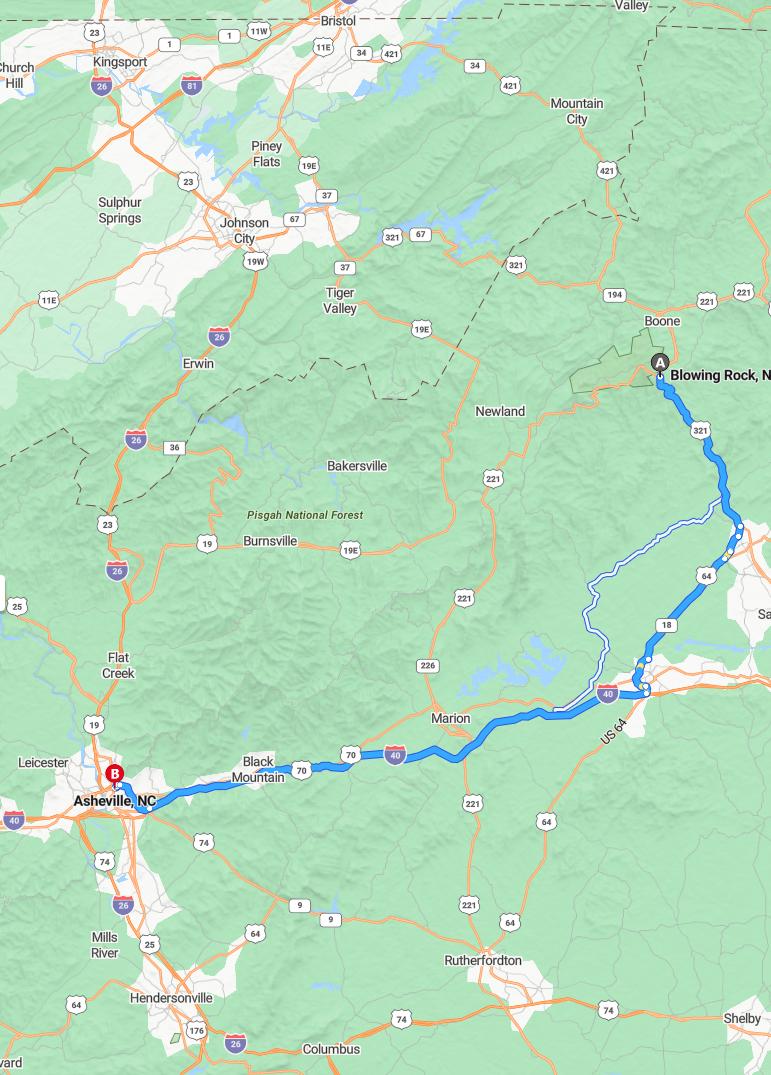Distance and estimated driving time
The drive from Blowing Rock to Asheville covers approximately 92 miles and typically takes around 1 hour and 42 minutes via US-321 S and I-40 W. This scenic route offers a quick and convenient way to travel between these two popular destinations in North Carolina. Travelers can enjoy the diverse landscapes along the highways, from mountainous views to lush forests. Planning for a smooth trip involves considering potential traffic delays and checking road conditions before departure.
Driving route
Traveling from Blowing Rock to Asheville offers a scenic journey through North Carolina's picturesque landscape. Starting in Blowing Rock, you'll pass through Boone, known for its vibrant college town atmosphere and outdoor activities. Continuing westward, you'll traverse Marion, a charming town with historical significance and inviting local culture. The route culminates in Asheville, renowned for its vibrant arts scene, stunning mountain vistas, and renowned culinary experiences. This drive provides a delightful blend of natural beauty and cultural attractions, making it an enjoyable trip for travelers seeking both relaxation and adventure.

Scenic points of interest along the route
The drive from Blowing Rock to Asheville offers a variety of scenic points of interest that showcase the natural beauty of North Carolina. Starting in Blowing Rock, visitors can enjoy panoramic views and explore the charming downtown area. As you pass through Boone, the scenic backdrop of the Blue Ridge Mountains and nearby Grandfather Mountain provide stunning vistas and opportunities for outdoor activities. Continuing towards Marion and finally Asheville, travelers are treated to winding mountain roads, lush forests, and picturesque overlooks that highlight the region's diverse landscape, making the trip as breathtaking as the destinations themselves.
Traffic conditions and potential delays
Driving from Blowing Rock to Asheville, travelers typically experience smooth traffic conditions with minimal delays. However, during peak tourist seasons or holiday weekends, congestion may occur near popular destinations like Boone and Blowing Rock, potentially causing slight delays. The route through Marion usually remains clear, allowing for steady travel. Overall, drivers can expect a relatively hassle-free journey, but it's advisable to check real-time traffic updates before departure to avoid any unforeseen congestion.
Best time to travel for scenic views
The best time to travel from Blowing Rock to Asheville for stunning scenic views is during the fall months, typically from late September to early November, when vibrant foliage colors blanket the landscape. During this period, the picturesque mountains and charming towns like Boone, Blowing Rock, and Marion are transformed by vivid reds, oranges, and yellows, offering incredible photo opportunities and memorable vistas. Spring, from April to early June, also provides beautiful scenery with blooming wildflowers and lush greenery, making it a great alternative for travelers seeking to enjoy nature's rebirth. To fully experience the rolling mountain scenery and avoid peak crowds, consider traveling on weekdays or early mornings within these seasons for a more tranquil and immersive viewing experience.
Road safety tips for drivers
When driving from Blowing Rock to Asheville, it is essential to prioritize road safety by staying attentive and maintaining a safe speed, especially through scenic areas like Boone, Blowing Rock, and Marion. Always adhere to posted speed limits and be cautious of curves and changing road conditions, as mountain routes can be unpredictable. Keep a safe following distance to allow ample reaction time and avoid sudden braking. Additionally, stay alert for wildlife, cyclists, and pedestrians, and ensure your vehicle is well-maintained before embarking on your journey through these picturesque towns.
Weather forecast and driving considerations
As you drive from Blowing Rock to Asheville, you can expect variable weather conditions, with possible rain showers and mild temperatures, especially in the mountainous regions. It's important to be prepared for winding mountain roads that may be slick or crowded, particularly during peak travel times. Check local weather forecasts before your trip to stay updated on any abrupt changes, such as thunderstorms or fog, which can reduce visibility. Maintaining caution and reducing speed on the scenic, curved highways will ensure a safe and enjoyable drive through these picturesque North Carolina towns.
Local dining options near the route
Along the scenic drive from Blowing Rock to Asheville, travelers can enjoy a variety of local dining options that highlight the region's culinary strengths. In Blowing Rock, cozy spots like the Speckled Trout Restaurant offer delicious Appalachian-inspired dishes, while in Boone, visitors can indulge in favorites such as Black Cat Burrito or the Mediterranean cuisine at Villa Nova. As you pass through Marion, there are charming diners and barbecue joints serving hearty Southern fare. Finally, once in Asheville, the vibrant food scene offers everything from farm-to-table restaurants like Tupelo Honey to eclectic eateries in the Downtown Asheville area, providing a memorable culinary experience along the journey.
Parking availability in Asheville
Asheville offers a variety of parking options for visitors, including downtown garages, street parking, and surface lots. Many areas have ample metered parking, with some zones offering free parking during certain hours or days. Parking garages such as the Pack Square Garage and Civic Center Garage provide convenient access to popular attractions and downtown shops. It is advisable to arrive early or plan ahead, especially during peak tourist season, to secure parking and enhance your visit to Asheville.
Alternative routes to consider
When traveling from Blowing Rock to Asheville, consider alternative routes beyond the primary highway. One option is to take the scenic Blue Ridge Parkway, which offers breathtaking mountain views and a more leisurely drive, though it may be slower and more winding. Alternatively, you could head south toward Marion and then east on local roads, providing a different landscape and potential stops along the way. Using GPS or map apps, travelers can explore these routes to enhance their journey with sightseeing opportunities or to avoid traffic congestion on the main highways.
